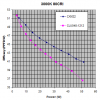Chronikool
Well-Known Member
Cxm22 you mean right..?@CobKits I was just checking out your site, I didn't realize you had some the new CXM-32 chips in stock. I would like to try them out, can you put me together a cob/driver/heatsink combo?
Cxm22 you mean right..?@CobKits I was just checking out your site, I didn't realize you had some the new CXM-32 chips in stock. I would like to try them out, can you put me together a cob/driver/heatsink combo?
What drivers did you choose? And what space have you got? Thinking of making a frame for it?Just purchased 8 x CXM22 light engines. May document here as no one else seems to to be.
Thankz for your service so far @CobKits ...awesome stuff.
2017 promises to be green..
Running 4 on each frame on a 320-C1400 in seperate 2.8 (80cm) x 2.8 tents. About 300w watts in each.What drivers did you choose? And what space have you got? Thinking of making a frame for it?
Im gonna run mine at 700ma (4) per 150 watt driver using 3 drivers. I am an efficiency freak. 12 in a 2'x4' tent and likely dimmed to 300 watts at the wall...25 watts per cob or 476 maRunning 4 on each frame on a 320-C1400 in seperate 2.8 (80cm) x 2.8 tents. About 300w watts in each.
Yeah.....will smash together a shitty frame for sure...
I just wanna grow weed...I am an efficiency freak.
Heck, you could run two cobs per 120mm pin fin at that wattage.Im gonna run mine at 700ma (4) per 150 watt driver using 3 drivers. I am an efficiency freak. 12 in a 2'x4' tent and likely dimmed to 300 watts at the wall...25 watts per cob or 476 ma
Running in series....and the volts are 50v on the cxm22.help me out here, i dont' think im getting the amps part.
so 4 cmx22's at 320-C1400 = 80 watts per 36v cob (but i could run more cobs becuase the voltage is higher)
and 4 cmx22's at 320-C2100 = 80 watts per 36v cob (only 4 cobs because the voltage is around 150)
how do the amps come into play if i only ran 4 cobs on each array
help me out here, i dont' think im getting the amps part.
so 4 cmx22's at 320-C1400 = 80 watts per 36v cob (but i could run more cobs becuase the voltage is higher)
and 4 cmx22's at 320-C2100 = 80 watts per 36v cob (only 4 cobs because the voltage is around 150)
how do the amps come into play if i only ran 4 cobs on each array
Me too, but small space or me so ant the most per tf^2 and runnin g them lower with moe cobs means might light and less heat because 2x4x5 tents heat up easy.I just wanna grow weed...
ok since you guys have been patient... its slow but steady. i made a mount for cobs up topAny ETA on when to check back in this thread for sphere testing? Just really interests me to see how accurate the manufacturers specs are compared to our real world usage. These COBs have come such a long way












Lookz like i made a good purchase. Cant wait to put them to work.so lets break it in with a couple of quick runs
View attachment 3857580
im gonna go out on a limb just by the look of the curves and say that the spot measurements i was doing previously werent too far off. but this is better as it is absolute. provided the ambient temperature is similar and i do a similar method of current ramping and datalogging, i can measure a few cobs today, one tomorrow, three next week and they should all be repeatable and absolute relative to one another as the sphere geometry is fixed, and theres nothing like sensor and chip placement, time of day/room brightness, color of pants im wearing, etc to affect the PAR readings. At this point, while were not really to the standards of a lab, i feel the accuracy is approaching or has exceeded the variability between individual chips from a bin/lot, and is as good as were gonna get for making relative generalizations about the performance of a chip series. That would be a separate test worth doing- pulling 3 or more chips from a lot and running them to see how variable a given bin/lot is. so what can we learn from this.
So what use is this data?
lets compare 2 chips at a fixed efficacy:
View attachment 3857581
a $12 1212 can get you just under 30W at that efficacy
a $17 CXM22 can get you 48W (61% more power) but only costs 42% more than a 1212
remember from previous tests 1212 was the heavyweight leader in $/PAR at a given efficiency- you just needed to use a lot of them. Here were getting a scale up at better-than-1212 economics to a more practical sized chip
The economics look stronger when you consider cost of holder, reflector, heatsink, mounting time, etc. Discrete heatsinks will always favor larger chips in installed cost

